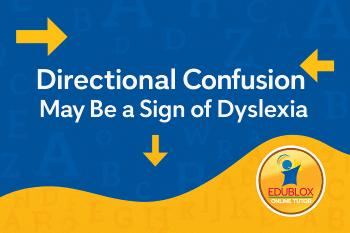
Most children look forward to learning to read and do so quickly. For children with dyslexia, however, the experience is very different. Reading — which seems to come effortlessly for everyone else — appears beyond their grasp.
The process of transforming what are essentially abstract squiggles on a page into meaningful letters, then sounds, then words, and finally sentences and paragraphs, feels impossible.
They grow frustrated and disappointed. Teachers often wonder what they or the child might be doing wrong, which can lead to misdiagnosing the problem or receiving poor advice. Parents question themselves, feeling alternately guilty and angry.
According to author Sally Shaywitz, dyslexia affects one out of every five children — about ten million in America alone. In every neighborhood and classroom worldwide, children are struggling to read. For many, dyslexia has dimmed the joys of childhood..
Directional confusion — a common symptom
Directional confusion is one of the most common symptoms of dyslexia and can manifest in various forms, ranging from uncertainty about left and right to difficulty reading a map accurately. It also affects concepts such as up and down, top and bottom, compass directions, keeping one’s place when playing games, or copying the gym teacher’s movements when they are facing you.

As many as eight out of ten severely dyslexic children experience directional confusion. The percentage is lower for those with milder forms.
Directional confusion may include:
• Left–right confusion
- A child should know their left and right by about age five and be able to distinguish someone else’s by age seven.
- Dyslexic individuals often rely on tricks they were taught to distinguish between left and right, even into adulthood.
- A common household saying is, “It’s on the left — the other left.”
- This explains why they often reverse b and d; one points left, the other right.
- They may read or write words like no for on, rat for tar, won for now, or saw for was.
- Some mirror-write letters, words, or numbers (e.g., writing ε for 3).
- They may start math problems on the wrong side, carry numbers incorrectly, or write 17 for 71.
• Up–down confusion
- Some children confuse letters such as b–p, d–q, n–u, m–w, and t–f.
• Confusion about directionality words
- Trouble understanding first–last, before–after, next–previous, over–under, and even time words like yesterday–tomorrow.
• Compass direction confusion
- Adults with dyslexia often struggle to find their way, even in familiar cities.
- Many have difficulty reading or interpreting maps.
Directional confusion also explains why many dyslexic children take longer to learn to tie their shoelaces. Most children master this by age five, but many with dyslexia struggle until ten or older — and even then, may not be consistently successful.
Overcoming the problem by addressing the cause
The inability to discriminate between b and d usually stems from a visual-perceptual problem, specifically a difficulty in processing position in space.
Before one can read or learn anything, one must first perceive it through the senses — usually by seeing or hearing. Perception involves both awareness and interpretation.
Lack of experience can lead to misinterpretation of what one sees or hears. In essence, perception reflects how we interpret new information in light of our past experiences. As philosopher Immanuel Kant noted:
“We see things not as they are but as we are.”

Consider this example: If you park your car and walk away while looking back, it appears to shrink. Yet you don’t panic — your experience tells you the car’s actual size remains constant. This learned understanding is called size constancy.
Anthropologist Colin Macmillan Turnbull, author of The Forest People, described how Pygmies who had lived deep in the African rainforest lacked such visual experience. When one man saw distant buffalo across open plains, he thought they were insects — and believed witchcraft had turned them into buffalo as he approached.
To summarize, one must have sufficient exposure to expansive vistas and distant horizons to develop size constancy. In the same way, to interpret position in space — the learned perception that enables us to distinguish a b from a d — a person must have had enough relevant experiences. Such experiences include learning to differentiate between left and right and being able to cross the body’s midline.
Edublox helps students with directional confusion
Edublox Online Tutor offers a range of programs that build the cognitive foundations of learning. Our products include Development Tutor, Reading Tutor, and Live Tutor.
For students with mild to severe dyslexia, Live Tutor combined with Development Tutor is recommended. Together they:
- Strengthen cognitive skills, including position in space;
- Teach decoding, a key reading skill involving segmenting and blending sounds; and
- Develop orthographic mapping, which links spelling patterns to word memory.
Watch the playlist below to see how Edublox training and tutoring help turn dyslexia around. Book a free consultation to discuss your child’s learning needs.
References for Directional Confusion May Be a Sign of Dyslexia:
- Hornsby, B. (1984). Overcoming dyslexia. Cape Town: Juta and Company Ltd.
- Shaywitz, S. (2005). Overcoming dyslexia. New York: Vintage Books.
- Turnbull, C. M. (1961). Some observations regarding the experiences and behavior of the Bambuti Pygmies. American Journal of Psychology, 74.
Directional Confusion May Be a Sign of Dyslexia was authored by Sue du Plessis (B.A. Hons Psychology; B.D.), a dyslexia specialist with 30+ years of experience in learning disabilities.
Edublox is proud to be a member of the International Dyslexia Association (IDA), a leading organization dedicated to evidence-based research and advocacy for individuals with dyslexia and related learning difficulties.



